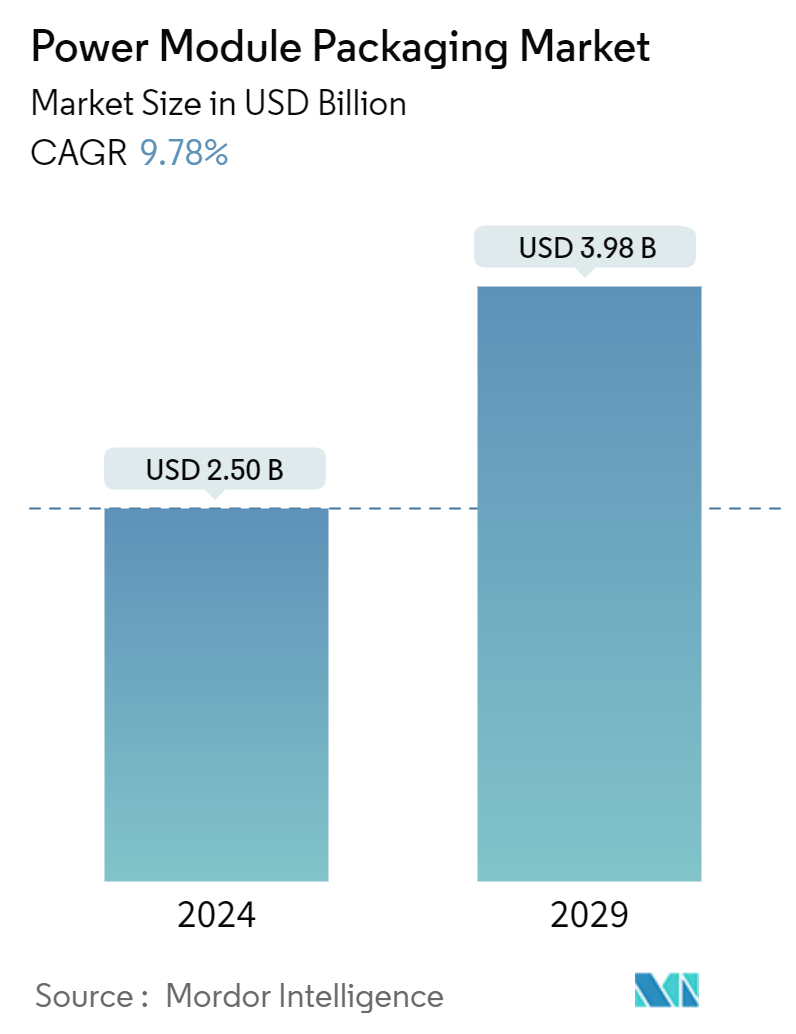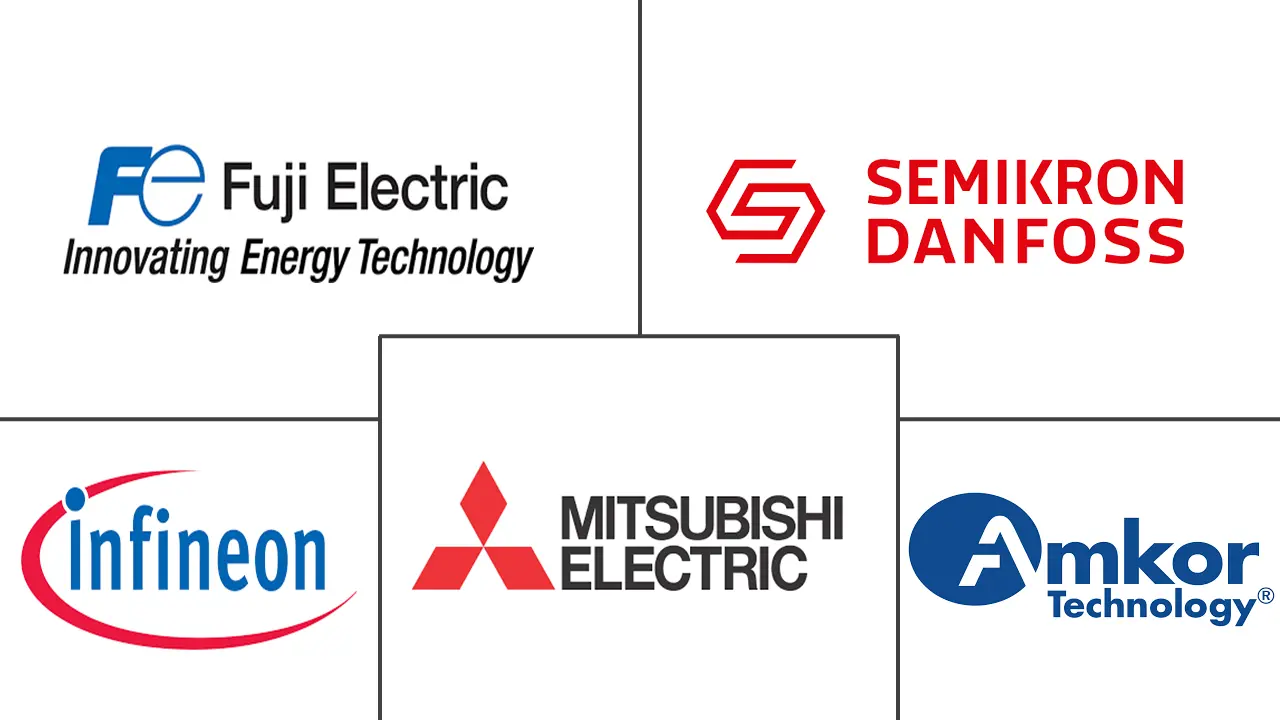Market Size of Power Module Packaging Industry

| Study Period | 2019 - 2029 |
| Market Size (2024) | USD 2.5 Billion |
| Market Size (2029) | USD 3.98 Billion |
| CAGR (2024 - 2029) | 9.78 % |
| Fastest Growing Market | Asia Pacific |
| Largest Market | Asia Pacific |
Major Players
*Disclaimer: Major Players sorted in no particular order |
Power Module Packaging Market Analysis
The Power Module Packaging Market size is estimated at USD 2.50 billion in 2024, and is expected to reach USD 3.98 billion by 2029, at a CAGR of 9.78% during the forecast period (2024-2029).
A power electronic module or power module acts as a physical container for storing several power components, usually power semiconductor devices. Packaging plays a crucial role in the shift toward higher power densities, which enables more efficient power supplies, faster conversion, power delivery, and improved reliability. As the world is shifting toward faster-switching frequencies and higher power densities, there is a related shift in packaging materials used for wire bonding, die-attach, substrates, and system cooling.
- The power modules are the key elements in the power inverters and converters. Power modules are commonly used in electric cars and other electric motor controllers, appliances, power supplies, electroplating machinery, medical equipment, battery chargers, AC to DC inverters and converters, power switches, and welding equipment. The power module packaging market's growth is driven by a reduction in the wastage of energy, the use of efficient distributed cooling schemes, a reduction in footprint, and a consequent increase in power density. Moreover, the growing demand for power modules in the industrial and consumer electronics sector is set to drive the power module packaging market.
- The consumer electronics industry has experienced a significant transformation driven by the rising demand for smarter and more advanced devices. Another important trend in the electronics industry is the increase of the Internet of Things (IoT). With the rise in demand for smart devices, IoT has become essential to everyday life. Thus, businesses primarily use this technology to develop new products and services. For instance, according to GSMA, greater China leads significantly with 1.5 billion connections, surpassing other regions, and is followed by North America and Europe with 0.3 billion connections each.
- Industrial appliances such as uninterruptible power supplies (UPS), server power supplies, power converters, and motor drives consume a significant portion of the world's power. Therefore, any increase in efficiency in industrial power supplies will substantially reduce a company's operating costs. With greater power density and better thermal performance, the demand for high-efficiency power supplies is increasing exponentially.
- The consolidation will increase as power module manufacturers grapple with the increasing complexity, the loss of a roadmap for future designs as Moore's Law is becoming more difficult and expensive to sustain, and a flood of new markets with evolving standards and different sets of rules.
- The Russia and Ukraine War is driving the aluminum and nickel prices upward, while high energy prices have affected metals, specifically copper. Copper is a crucial material in the power module packaging market, and it is used in baseplate and electrical interconnections. Copper price fluctuations will directly impact the power module packaging market. Metal prices were expected to increase 16% in 2022 and ease somewhat in 2023, according to ukraineinvest.gov. The ongoing war between Russia and Ukraine, stricter emissions standards in China, and high energy costs are the main factors in the increasing shortage of copper.
Power Module Packaging Industry Segmentation
A power module or power electronic module acts as a physical container for the storage of several power components, usually power semiconductor devices. The market growth is driven by a reduction in energy wastage, the use of efficient distributed cooling schemes, a reduction in footprint, and a consequent increase in power density. Moreover, the growing demand for power modules in the industrial and consumer electronics sectors is likely to drive the growth of the power module packaging market.
The power module packaging market is segmented by technology (substrate, baseplate, die-attach, substrate attach, encapsulations, interconnections, and other technologies) and geography (North America, Europe, Asia-Pacific, and the Rest of the World). The market sizes and forecasts are provided in terms of value in USD for all the above segments.
| By Technology | |
| Substrate | |
| Baseplate | |
| Die Attach | |
| Substrate Attach | |
| Encapsulations | |
| Interconnections | |
| Other Technologies |
| By Geography*** | |
| North America | |
| Europe | |
| Asia | |
| Australia and New Zealand | |
| Latin America | |
| Middle East and Africa |
Power Module Packaging Market Size Summary
The power module packaging market is poised for significant growth, driven by the increasing demand for efficient power solutions across various sectors. Power modules, essential components in power inverters and converters, are gaining traction due to their application in electric vehicles, consumer electronics, and industrial machinery. The shift towards higher power densities and faster-switching frequencies is prompting advancements in packaging materials, enhancing power delivery and reliability. The market is further bolstered by the transition from silicon IGBTs to SiC MOSFETs, which are being adopted for their superior performance in automotive and other applications. This technological evolution is supported by the rising demand for electric vehicles and the proliferation of IoT devices, which necessitate innovative power module packaging solutions.
Regionally, the Asia-Pacific area is expected to dominate the market, fueled by the adoption of renewable energy and the growth of electric vehicles, particularly in China and India. These countries are making substantial investments in renewable energy infrastructure, which is driving the demand for power modules. The market is characterized by a semi-consolidated landscape, with major players like Fuji Electric, Infineon Technologies, and Mitsubishi Electric actively engaging in strategic partnerships and product innovations to maintain a competitive edge. Recent developments, such as Infineon Technologies' launch of the 4.5 kV XHP 3 IGBT modules and Fuji Electric's introduction of the P633C Series, highlight the industry's focus on reducing power consumption and enhancing efficiency. These trends indicate a robust growth trajectory for the power module packaging market in the coming years.
Power Module Packaging Market Size - Table of Contents
-
1. MARKET DYNAMICS
-
1.1 Market Drivers
-
1.1.1 Increasing Demand from the Industrial and Consumer Electronics Segment
-
1.1.2 Rising Demand for Energy-efficient Devices
-
-
1.2 Market Restraints
-
1.2.1 Market Consolidation Affecting Overall Profitability
-
-
-
2. MARKET SEGMENTATION
-
2.1 By Technology
-
2.1.1 Substrate
-
2.1.2 Baseplate
-
2.1.3 Die Attach
-
2.1.4 Substrate Attach
-
2.1.5 Encapsulations
-
2.1.6 Interconnections
-
2.1.7 Other Technologies
-
-
2.2 By Geography***
-
2.2.1 North America
-
2.2.2 Europe
-
2.2.3 Asia
-
2.2.4 Australia and New Zealand
-
2.2.5 Latin America
-
2.2.6 Middle East and Africa
-
-
Power Module Packaging Market Size FAQs
How big is the Power Module Packaging Market?
The Power Module Packaging Market size is expected to reach USD 2.5 billion in 2024 and grow at a CAGR of 9.78% to reach USD 3.98 billion by 2029.
What is the current Power Module Packaging Market size?
In 2024, the Power Module Packaging Market size is expected to reach USD 2.5 billion.

